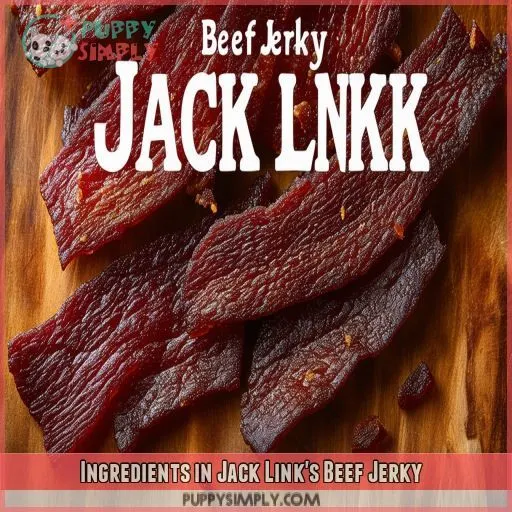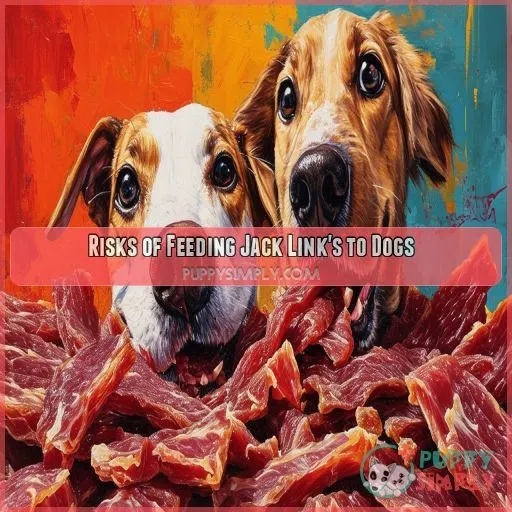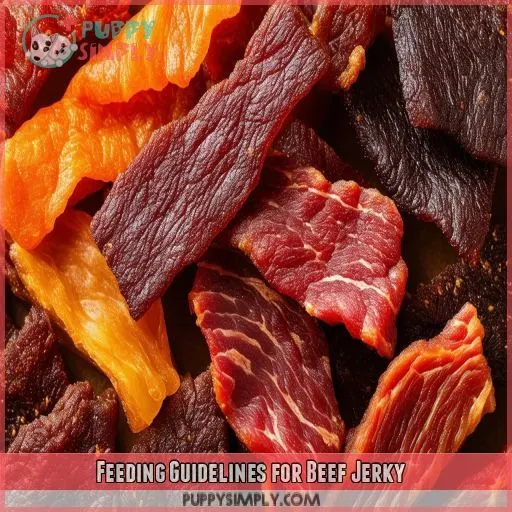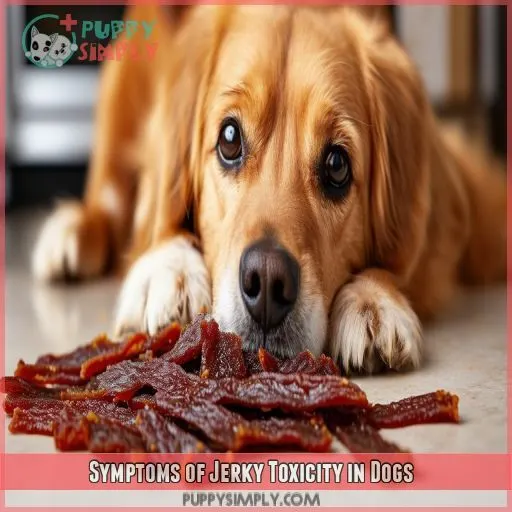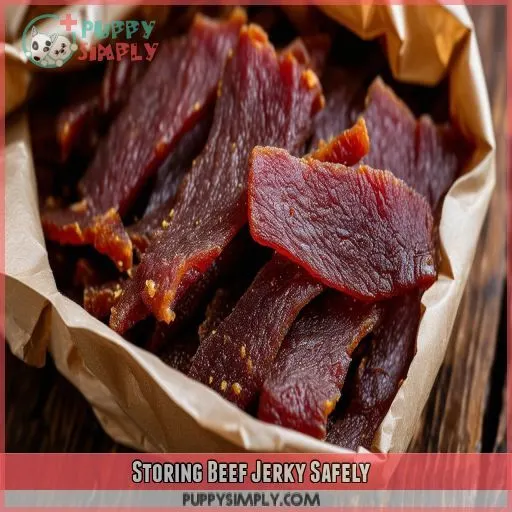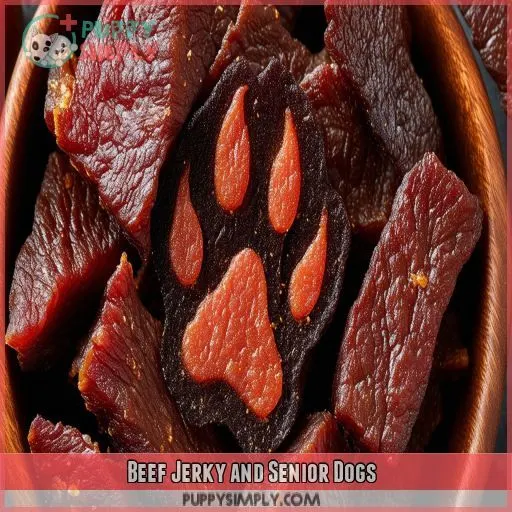This site is supported by our readers. We may earn a commission, at no cost to you, if you purchase through links.

This increasingly popular treat has some serious potential dangers for your fur baby. From harmful ingredients to choking hazards, it is a critical issue to understand the risks associated with them.
We’ll discuss safer options, feeding guidelines, and when to seek veterinary care so your pup stays healthy while he gets his meat on
Table Of Contents
- Key Takeaways
- Can Dogs Eat Beef Jerky Jack Links?
- Ingredients in Jack Link’s Beef Jerky
- Risks of Feeding Jack Link’s to Dogs
- Safer Alternatives to Jack Link’s
- Feeding Guidelines for Beef Jerky
- Symptoms of Jerky Toxicity in Dogs
- When to Seek Veterinary Care
- Storing Beef Jerky Safely
- Beef Jerky and Puppies
- Beef Jerky and Senior Dogs
- Frequently Asked Questions (FAQs)
- Is beef jerky safe for dogs to eat?
- What happens if a dog eats the thing in beef jerky?
- Can dogs eat Slim Jims?
- Is Jack Link’s beef jerky ready to eat?
- Can dogs eat Jack Link’s beef jerky?
- Can dogs eat jerky?
- Can dogs eat Pacific Gold beef jerky?
- Can dogs eat beef jerky sticks?
- How Much Jack Link’s Beef Jerky Should I Give My Dog?
- Is Jack Link’s Beef Jerky Suitable for All Life Stages?
- Are There Any Other Flavors of Jack Link’s Beef Jerky That Are Safe for Dogs?
- Are There Any Other Brands of Beef Jerky That Are Safe for Dogs?
- What is the Best Way to Store Jack Link’s Beef Jerky for Dogs?
- Can dogs have Jack Links beef jerky as a training treat?
- How much Jack Links jerky can cause sodium poisoning?
- Are some Jack Links flavors safer for dogs than others?
- Does Jack Links make any dog-specific jerky products?
- Can Jack Links beef jerky cause long-term health issues in dogs?
- Conclusion
Key Takeaways
- Hold your horses before tossing Fido a piece of Jack Link’s! This beefy treat is a wolf in sheep’s clothing, packed with salt, spices, and preservatives that can turn your pup’s tummy into a danger zone.
- When it comes to jerky for your furry friend, homemade is where the heart is. Whip up some plain, unseasoned beef jerky treats to keep your pooch’s tail wagging without the worry.
- If your four-legged foodie manages to snag some Jack Link’s, keep your eyes peeled for the doggy distress signals: vomiting, diarrhea, or sudden couch potato syndrome. When in doubt, give the vet a shout!
- Remember, one size doesn’t fit all in the canine snack world. Puppies and senior dogs are like delicate flowers – their tummies need extra TLC, so stick to vet-approved treats tailored to their life stage
Can Dogs Eat Beef Jerky Jack Links?
You shouldn’t feed your dog Jack Link’s beef jerky, as it contains ingredients that can be harmful to canines. The high sodium content, preservatives, and potential toxins like onion and garlic can cause serious health issues. Risks include gastrointestinal upset, pancreatitis, and even sodium poisoning.
Instead, opt for plain, unseasoned beef jerky or dog-specific treats. If you do offer jerky, introduce it slowly and in small amounts, always monitoring for digestive issues.
Keep an eye out for symptoms like vomiting, diarrhea, or lethargy, which may indicate jerky toxicity. When in doubt, consult your vet.
There’s more to know about keeping your furry friend safe and satisfied
Ingredients in Jack Link’s Beef Jerky
Jack Link’s Beef Jerky contains several ingredients that can be harmful to dogs, including onion, garlic, spices, and high sodium levels. You’ll also find preservatives and additives in this popular snack, which aren’t ideal for your canine companion’s digestive system
Potential Toxins: Onion, Garlic, Spices
You’ll want to be cautious when considering Jack Link’s for your furry friend. The ingredients can pose risks:
- Onion and garlic: Toxic to dogs, causing anemia
- Spices: May trigger allergies or pancreatitis
- Xylitol: Extremely dangerous artificial sweetener
- Preservatives: Can lead to dehydration
Instead, try homemade dog beef jerky treats or plain dried jerky
High Sodium Content
You’ll find store-bought beef jerky like Jack Link’s packed with salt. While dogs can handle some sodium, too much can lead to fluid retention, excessive thirst, and dehydration. In severe cases, it might even cause blood pressure spikes, kidney damage, or sodium poisoning (hypernatremia). It’s best to limit your pup’s intake
Preservatives and Additives
Jack Link’s beef jerky contains preservatives and additives you’ll want to watch out for. Onion powder, sugar, teriyaki sauce, and black pepper are common ingredients that can upset your dog’s stomach. Some varieties also include spicy flavors, which aren’t dog-friendly. Always check the label before sharing any human food with your furry friend
Risks of Feeding Jack Link’s to Dogs
Feeding Jack Link’s beef jerky to your dog can lead to several health risks, including gastrointestinal upset, pancreatitis, sodium poisoning, and potential choking hazards. You’ll need to be aware of these dangers and consider safer alternatives to protect your pet’s well-being
Gastrointestinal Upset
Feeding your dog beef jerky can upset their stomach. The high salt content and lack of dietary fiber may cause diarrhea and dehydration. Your pup’s digestion isn’t built for processed treats, so consider homemade dog jerky treats instead for safer snacking
Pancreatitis
You should be aware that feeding your dog Jack Link’s jerky can trigger pancreatitis. This painful condition inflames the pancreas, causing vomiting and abdominal pain. High-fat treats like jerky are a common culprit, so it’s best to avoid them entirely
Sodium Poisoning
You’ve heard of pancreatitis, but another risk is sodium poisoning. Jack Link’s contains a large amount of salt, which knocks out of whack the electrolyte level in your dog—this can cause dehydration. Consider low-sodium treats or homemade jerky for safe alternatives. Remember that moderation is essential when it comes to snacks:
Choking Hazard
You should be cautious when giving your dog Jack Link’s jerky. Its tough texture can pose a choking risk, especially for small breeds or older dogs. Consider your dog’s size, age, and medical history before offering any jerky treats
Safer Alternatives to Jack Link’s
You can offer your dog safer alternatives to Jack Link’s beef jerky that are healthier and less risky. Consider giving them plain, unseasoned beef jerky, homemade dehydrated meat treats, or commercial dog-safe jerky treats specifically designed for canine consumption
Plain, Unseasoned Beef Jerky
You can have plain, unseasoned beef jerky as a safer alternative to Jack Link’s. This snack is more durable due to methods of dehydration. It still contains most of the nutritional value without any harmful additions.
Be sure to store it safely in airtight containers.
Even though you can buy commercial jerky, homemade versions will enable you to manage the ingredients for the sake of your pup’s health
Homemade Dehydrated Meat Treats
You can make safe, homemade jerky treats for your pup. Try dehydrating lean meats like chicken or beef without added salt or spices. These treats offer high nutritional value and make excellent training rewards. Use proper dehydration methods and store your homemade jerky in airtight containers. Your dog will love these tasty, healthy snacks!
Commercial Dog-safe Jerky Treats
You’ll find plenty of commercial dog-safe jerky treats on the market. These are formulated to meet dog treat safety standards, often containing fewer preservatives than human snacks. While they’re convenient, always check the ingredients. Some brands offer dog-friendly jerky flavorings that’ll make your pup’s tail wag without compromising their health
Feeding Guidelines for Beef Jerky
While introducing beef jerky to your dog, always start with small portions so you might understand if he’s prone to stomach upset. Finally, it’s essential to have jerky only as an occasional reward and not as a lone substitute for his regular meal to keep him on a balanced diet.
Introduce Slowly in Small Amounts
When introducing safer jerky alternatives, start small. Consider your dog’s size and choose appropriate portions. Offer different flavors gradually:
- Plain beef jerky (no additives)
- Homemade dehydrated chicken
- Commercial dog-safe turkey jerky
Begin with tiny pieces, increasing slowly over time. This cautious approach helps prevent digestive upset and allows you to gauge your pup’s reaction
Monitor for Digestive Issues
When giving your dog beef jerky, keep a close eye on their digestive health. Watch for signs of dehydration or upset stomach. If you notice any issues, consider medication options to soothe their stomach lining. Monitor their weight and blood sugar levels, as jerky can be high in calories and sodium
Avoid Feeding as a Main Meal
Remember, while monitoring your dog’s reactions to the treat, that beef jerky can’t replace balanced meals; nutrition should be done correctly. Consider the following guidelines:
- Offer as occasional treats only
- Keep portion sizes in line with your dog’s weight
- Healthier alternatives explores**, such as homemade treats.
• Consult your vet for individual advice
- Always prioritize a complete, well-balanced diet
Symptoms of Jerky Toxicity in Dogs
If your dog has eaten beef jerky, watch for signs of toxicity such as vomiting, diarrhea, lethargy, and loss of appetite. These symptoms can indicate a negative reaction to the jerky’s ingredients or sodium content, and you should contact your vet if they persist or worsen
Vomiting
If your dog eats Jack Link’s jerky, watch for vomiting. It’s a key sign of toxicity and can lead to dehydration and electrolyte imbalances. Repeated vomiting may irritate the stomach lining or indicate pancreatitis. Don’t wait – contact your vet if vomiting persists
Diarrhea
If your dog’s eaten Jack Link’s, watch for diarrhea. It’s a sign their gut’s unhappy. Increase water intake and consider a bland diet. Safe dehydration can occur, so keep them hydrated. Digestive enzymes might help, and pet insurance could cover vet visits
Lethargy
If your dog’s eaten Jack Link’s jerky, watch for lethargy. It’s a red flag for:
- Dehydration
- Electrolyte imbalance
- Pancreatitis
Your pup might seem unusually tired or uninterested in activities. Don’t ignore this sign – it could indicate a serious reaction
Loss of Appetite
If your dog stops eating after consuming Jack Link’s, it’s a red flag. This could indicate allergies or dehydration. Monitor their weight, blood sugar, and dental health. A lack of appetite may signal your pup’s body is rejecting the jerky
When to Seek Veterinary Care
If your dog suffers from continuous vomiting or diarrhea, lack of appetite, signs of dehydration, or any neurological symptoms after eating beef jerky, then it’s time to take him to the vet. It could mean a severe reaction is occurring, and quick treatment will ensure the continued health and well-being of your dog.
Persistent Vomiting or Diarrhea
If your dog’s vomiting or diarrhea persists after eating Jack Link’s, it’s time to call the vet. Prolonged symptoms can lead to:
- Severe dehydration and electrolyte imbalance
- Potential pancreatitis from high fat content
- Sodium toxicity from excessive salt intake
Don’t wait – act quickly!
Decreased Appetite
If vomiting or diarrhea persists, watch for decreased appetite. It’s a red flag that shouldn’t be ignored. Here’s what to look out for:
| Symptom | Duration | Action |
|---|---|---|
| No eating | 24 hours | Call vet |
| Picking at food | 48 hours | Monitor |
| Refusing treats | Immediate | Assess |
Dehydration
Observe your dog for dehydration after beef jerky consumption. If you trace the following in your dog, treat it as an emergency condition:
• Dry, sticky gums
- Sunken eyes
• Loss of elasticity of the skin
• Lethargy
• Decreased urination
Prevent dehydration by offering fresh water and limiting jerky intake
Neurological Symptoms
If dehydration worsens, watch for neurological symptoms. These can indicate severe complications from beef jerky consumption. Here’s a quick guide:
| Symptom | Cause | Action |
|---|---|---|
| Confusion | Electrolyte imbalance | Seek vet care |
| Seizures | Brain damage | Emergency vet |
| Lethargy | Coma risk | Immediate help |
| Disorientation | Dehydration | Rehydrate, monitor |
| Weakness | Neurological effects | Vet consultation |
Storing Beef Jerky Safely
To keep your dog safe, store beef jerky out of their reach in airtight containers. Regularly check expiration dates and discard any expired jerky to prevent potential health risks for your pet
Keep Out of Reach of Dogs
Now that you know when to take your dog to the vet, it’s time to prevent problems by keeping that beef jerky out of reach for your dog.
Keep your human foods in high cabinets or locked drawers
Use Airtight Containers
Airtight containers keep your beef jerky fresh and your furry friend out of trouble. Think vacuum sealing or, better yet, BPA-free lined containers for the best conditions in storage. Freezer storage prolongs shelf life, and desiccant packets keep it dry. Such alternative storage methods ensure your jerky is tasteful and beyond Fido’s grasp.
Check Expiration Dates
Always check the expiration date on the packaging of beef jerky. Storage conditions may alter its shelf life, so monitor temperature and humidity. If you have transferred to alternative storage containers, label it with an original expiry date if you stored the jerky in a different container. Safe handling is critical; discard any smelly or moldy-appearing jerky.
Beef Jerky and Puppies
You shouldn’t feed beef jerky to puppies under 6 months old due to their sensitive digestive systems and higher choking risk. It’s best to stick to puppy-specific foods and treats until they’re older and their digestive systems are more developed
Avoid Feeding to Puppies Under 6 Months
Don’t feed puppies beef jerky under six months. Their puppy development requires specific nutritional needs that jerky just doesn’t satisfy. Focus on puppy-appropriate foods and homemade treats instead. Use this time for behavior training and dental health care—the works. Stick to the vet-recommended diets so your pup grows and ages properly.
Puppies Have Sensitive Digestive Systems
Your puppy’s digestive system is delicate, making beef jerky a risky treat. Their developing gut can’t handle the heavy processing and high sodium content. Instead, focus on puppy-specific nutrition to support healthy growth.
- Avoid introducing new foods too quickly
- Monitor for signs of allergies or intolerances
- Stick to vet-recommended puppy diets
Choking Risk is Higher
As puppies grow, their choking risk remains high. You’ll need to be extra cautious with jerky. Consider safer alternatives like homemade treats or specially designed puppy snacks. If you do offer jerky, cut it into tiny pieces and supervise closely. Always prioritize dog safety by storing treats securely out of your pup’s reach
Beef Jerky and Senior Dogs
When feeding beef jerky to senior dogs, you’ll need to be extra cautious about portion sizes and adjust based on their individual health needs. It’s best to consult with your veterinarian before introducing beef jerky into your older dog‘s diet, as they can advise on any potential risks or contraindications specific to your pet’s health condition
Monitor Portion Sizes
When feeding beef jerky to senior dogs, you’ll need to keep a close eye on portion sizes. Their aging digestive systems can be more sensitive, so start small. Monitor for any symptoms of digestive issues. If you’re unsure, stick to safe alternatives or follow strict feeding guidelines. Your pup’s health comes first!
Adjust Based on Individual Health Needs
When adjusting beef jerky portions for senior dogs, consider their individual health needs. As your furry friend ages, their metabolism slows down, and they may develop specific dietary requirements. You’ll need to tailor beef jerky portions accordingly. Keep an eye on their weight, energy levels, and any existing health conditions to strike the right balance
Consult With a Veterinarian
This is also very important when adjusting the portions. You should consult your vet about feeding beef jerky to senior dogs. They’ll help in:
• Determine serving sizes
• Review ingredients for potential toxicity
• Suggest safe feeding techniques
Your vet can also advise on home remedies in the case of mild issues and treatment in case of toxicity. Keep in mind, also, the peculiar health conditions of your aged dog at all times.
Frequently Asked Questions (FAQs)
Is beef jerky safe for dogs to eat?
Beef jerky isn’t safe for your dog. It’s high in salt and often contains harmful ingredients like garlic or onion. You’re better off giving your pup specially-made dog treats or plain, unseasoned meat instead
What happens if a dog eats the thing in beef jerky?
90% of beef jerky packets contain silica gel. If your dog eats it, don’t panic. It’s non-toxic but may cause mild stomach upset. Monitor for vomiting or diarrhea. Feed a bland diet and contact your vet if symptoms persist
Can dogs eat Slim Jims?
You shouldn’t feed your dog Slim Jims. They’re high in salt, fat, and spices that can upset your pup’s stomach. Stick to dog-specific treats or plain, unseasoned meats for safer snacking options
Is Jack Link’s beef jerky ready to eat?
Yes, Jack Link’s beef jerky is ready to eat straight from the package. It’s fully cooked and shelf-stable, so you can enjoy it immediately. Just tear open the bag and savor the flavorful, protein-packed snack whenever you’re craving it
Can dogs eat Jack Link’s beef jerky?
You shouldn’t feed your dog Jack Link’s beef jerky. It’s high in salt and may contain harmful ingredients like garlic or onion. Opt for plain, unseasoned jerky or homemade treats instead to keep your furry friend safe and healthy
Can dogs eat jerky?
You shouldn’t feed your dog jerky. It’s often high in salt and may contain harmful ingredients like garlic or onions. If you’re set on giving jerky, opt for plain, homemade versions without additives. Always prioritize your pup’s health
Can dogs eat Pacific Gold beef jerky?
Picture your pup eyeing that Pacific Gold beef jerky. You shouldn’t share it. It’s often high in salt and spices that can upset your dog’s tummy. Stick to specially made dog treats for a safer snack option
Can dogs eat beef jerky sticks?
You shouldn’t feed your dog beef jerky sticks. They’re often high in salt and may contain harmful ingredients like garlic or onion. Instead, opt for specially made dog treats or plain, unseasoned cooked meat as occasional rewards
How Much Jack Link’s Beef Jerky Should I Give My Dog?
Like a ticking time bomb, Jack Link’s Beef Jerky isn’t safe for dogs. You shouldn’t give any to your furry friend. It’s high in salt and contains potentially harmful ingredients. Opt for dog-specific treats instead to keep your pup healthy
Is Jack Link’s Beef Jerky Suitable for All Life Stages?
Jack Link’s Beef Jerky isn’t suitable for all dog life stages. It’s high in salt and preservatives, which can be harmful to puppies, seniors, and dogs with health issues. You’re better off choosing age-appropriate, dog-specific treats instead
Are There Any Other Flavors of Jack Link’s Beef Jerky That Are Safe for Dogs?
No Jack Link’s beef jerky flavors are safe for dogs. They’re high in salt and often contain harmful ingredients like garlic or onion. It’s best to avoid giving your pup any commercial jerky treats, including Jack Link’s
Are There Any Other Brands of Beef Jerky That Are Safe for Dogs?
Did you know that 85% of dog owners treat their pets like family? Regarding beef jerky, you’re better off avoiding commercial brands. You’re better off making your canine-safe jerky treats at home.
What is the Best Way to Store Jack Link’s Beef Jerky for Dogs?
You shouldn’t store Jack Link’s beef jerky for dogs. It’s not safe for them to eat. Instead, keep your dog’s treats in an airtight container in a cool, dry place. This’ll ensure freshness and prevent spoilage
Can dogs have Jack Links beef jerky as a training treat?
You’d be barking up the wrong tree! Jack Link’s beef jerky isn’t ideal for dog training treats. It’s packed with salt and spices that can upset your pup’s tummy. Stick to dog-specific treats for safer, tail-wagging training sessions
How much Jack Links jerky can cause sodium poisoning?
You shouldn’t give your dog Jack Links jerky. The amount causing sodium poisoning varies, but even small amounts can be harmful. It’s best to avoid it entirely and choose dog-specific treats for your pup’s safety
Are some Jack Links flavors safer for dogs than others?
Imagine Fido sneaking a bite of teriyaki jerky. While no Jack Links flavors are truly safe, plain varieties are less risky. You’ll want to avoid flavors with garlic, onion, or excessive spices. Always prioritize your dog’s health
Does Jack Links make any dog-specific jerky products?
Jack Links doesn’t produce dog-specific jerky products. They focus on human snacks. For your pup’s safety, it’s best to avoid giving them any Jack Links jerky. Consider specialized dog treats or homemade jerky instead for a canine-friendly option
Can Jack Links beef jerky cause long-term health issues in dogs?
While occasional treats seem harmless, regular consumption of Jack Links beef jerky can potentially lead to long-term health issues in dogs. High sodium content and artificial additives may contribute to kidney problems, obesity, and digestive issues over time
Conclusion
You must, at all costs, however, like an acrobat balancing between safety and indulgence, find out whether it’s safe for dogs to feed on beef jerky or even Jack Link’s.
While one is always tempted to share the snack, in most cases, the risks outweigh the benefits. Go for safer alternatives and follow strictly the proper guidelines in feeding.
Always remember that the health of your dog is the most important. With this information and a watchful eye, you’ll ensure that your furry friend gets to enjoy treats without jeopardizing their well-being.
When in doubt, consult your vet for personalized advice on your dog’s dietary needs


